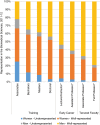From the NIH: A Systems Approach to Increasing the Diversity of the Biomedical Research Workforce
- PMID: 27587850
- PMCID: PMC5008902
- DOI: 10.1187/cbe.16-03-0138
From the NIH: A Systems Approach to Increasing the Diversity of the Biomedical Research Workforce
Abstract
The National Institutes of Health (NIH) is committed to attracting, developing, and supporting the best scientists from all groups as an integral part of excellence in training. Biomedical research workforce diversity, capitalizing on the full spectrum of skills, talents, and viewpoints, is essential for solving complex human health challenges. Over the past few decades, the biomedical research workforce has benefited from NIH programs aimed at enhancing diversity. However, there is considerable room for improvement, particularly at the level of independent scientists and within scientific leadership. We provide a rationale and specific opportunities to develop and sustain a diverse biomedical research workforce through interventions that promote the successful transitions to different stages on the path toward completion of training and entry into the biomedical workforce.
© 2016 H. A. Valantine et al. CBE—Life Sciences Education © 2016 The American Society for Cell Biology. This article is distributed by The American Society for Cell Biology under license from the author(s). It is available to the public under an Attribution–Noncommercial–Share Alike 3.0 Unported Creative Commons License (http://creativecommons.org/licenses/by-nc-sa/3.0).
Figures



References
MeSH terms
LinkOut - more resources
Full Text Sources
Other Literature Sources
Miscellaneous

